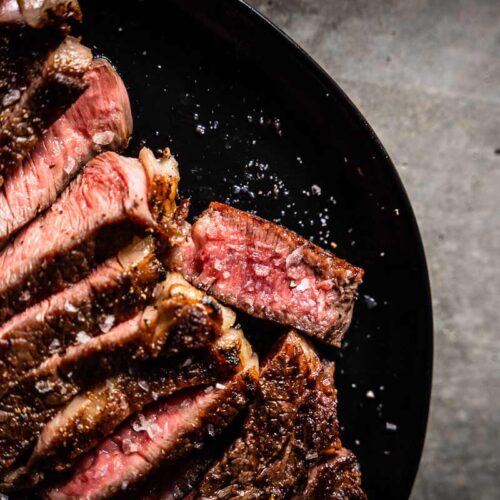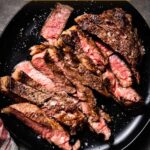A perfectly cooked steak is all about getting it to the ideal internal temperature to match your preferred doneness. For most steaks, medium-rare is considered the optimal doneness for the optimal flavor and tenderness, but personal preferences vary. In this quick guide, we’ll go through all the levels of steak doneness from rare to well-done, along with plenty of pro tips and recommendations.
Steak Doneness Chart
| Steak Doneness | Temperature (after resting) |
|---|---|
| Rare | 120 to 130° F |
| Medium-Rare | 130 to 135° F |
| Medium | 135 to 145° F |
| Medium-Well | 145 to 155° F |
| Well-Done | 155° F + |
Click each temperature to jump down to a description and pull temps.
Carryover Cooking and Steak
A very important consideration is that a steak’s internal temperature will continue to rise after it is removed from the heat source from the residual heat in the steak. This is called carryover cooking. For steak, the internal temperature will rise about 5-7°F from carryover cooking, depending on its size and cooking method used.
This means you will need to remove the steak from the heat 5 to 7° F before it reaches your desired final doneness temperature to account for this, or it will actually be overcooked beyond the temperature you were going for.
The larger and thicker the cut of steak and the higher the temperature you were cooking it at, the more carryover cooking there will be since it retains more residual heat. Learn more in the carryover cooking guide.
Steak Temperatures
Below are descriptions of each steak temperature range and details of the temperature you should remove it from the heat to achieve the target finished temperature.
Rare Steak Temp
Rare steak has a bright red and cool interior throughout.
Stop Cooking at: 115 to 125° F
Finished Temperature: 120 to 130° F
Recommended Cut: A filet mignon or beef tenderloin is the perfect candidate for cooking rare because of its very low fat content and super tender texture that quickly dries out if overcooked.
Medium Rare Steak Temp
Medium rare steak has a slightly warm interior with a reddish-pink center.
Stop Cooking at: 125 to 130° F
Finished Temperature: 130 to 135° F
Recommended Cut: Ribeye, strip steak, T-bone
Medium Steak Temp
A medium steak has a vibrant pink center with no remaining red. It is warmed all the way through.
Stop Cooking at: 130 to 140° F
Finished Temperature: 135 to 145° F
Recommended Cut: Flank steak, hanger steak, flat iron. These naturally tougher cuts benefit from a slightly higher temp to help make them more tender.
Medium Well Steak Temp
Medium well steak has just a hint of pink in the hot center and is starting to firm up the texture.
Stop Cooking at: 140 to 150° F
Finished Temperature: 145 to 155° F
Recommended Cut: Ribeye which has the highest fat content and is least likely to dry out.
Well Done Steak Temp
Well done steak is uniformly greyish-brown from edge to edge with no pink remaining.
Stop Cooking at: 155° F
Finished Temperature: 155° F +
Recommended Cut: Consider utilizing a braised cut like beef short ribs or go for a super low and slow cut like smoked brisket.
Pro Tips and Things to Consider for Achieving the Perfect Steak Temp
- Cook to temperature, and not by time. It’s all about the thickness of the steak, and not the overall weight that determines cook time. Fat content also plays a big role. A fatty marbled steak like a ribeye will cook slower and be more forgiving than a very lean cut like a filet, which cooks quickly and can get dry and tough when overcooked.
- The rarer you want the steak, the hotter and faster it should be cooked. This allows you to get a flavorful crust before the steak cooks too much.
- The more well done you want the steak, the lower and slower it should be cooked. This is so it will cook evenly without drying out before it reaches the desired temp.
- Salt your meat early. Plenty of kosher salt applied to the entire surface up to 24 hours ahead of time will do wonders for the flavor, tenderness and overall results of the steak.
- Rely on an instant-read meat thermometer to do the work of checking doneness. Learn more about the best meat thermometers.

How to Take a Steak’s Temp
- Insert your instant-read probe thermometer into the middle thickest part and push it all the way through the steak well past the middle, avoiding bones or large pieces of fat.
- Slowly pull it back until you see the lowest temperature reading, which will be the center of the meat.
The Importance of Resting Steak
Resting the steak after cooking is essential to maximum juiciness and flavor. As the steak cooks, the fibers tighten and squeeze juices out. If sliced into. immediately after cooking these juices will run out and be lost. Resting allows the fibers to relax and the juices to redistribute back into the meat.
As a rule, you should let steaks rest for at least 5 minutes up to 10 minutes for thicker cuts. And remember, the steak isn’t at its final temp until it is done resting.
The Best Ways to Cook a Steak
From the classic pan seared to modern sous vide, there’s a variety of cooking methods each with its own advantages and cut of steak that they are optimal for, which makes it so you don’t have to choose a favorite.
- Grill – The high direct heat of the grill gives the steak a beautiful and flavorful crust while imparting a tasty smoky flavor.
- Reverse Sear – Cooking the steak slowly in a low oven first allows the inside to cook evenly throughout before searing in a super hot skillet to add a flavorful crust.
- Sous Vide – The precise temperature control of the water bath ensures edge-to-edge perfect doneness with no over or undercooked spots.
- Smoking – The low-heat smoking adds a delicious smoky flavor to the meat before finishing with a sear either on a hot grill or in a skillet. This is a similar method to the reverse-sear, but with the addition of delicious smoke flavor.
- Quick Flip Cold Pan Method – Starting with a cold skillet and turning it up to high, flipping the steak every two minutes allows the exterior to brown evenly to form a great crust, while very evenly cooking the interior. Also great for Steak au Poivre (pepper steak).
- Oven – Roasting a steak in the oven is convenient and mostly hands-off. It’s best to sear it for a flavorful crust either before or after it cooks in the oven.
- Cast iron skillet – The excellent heat retention of cast iron produces superior browning and crust formation. A steak that isn’t too thick can be completely cooked on the stove in a cast iron skillet.
- Butter Basting – Spooning herb and garlic-infused butter over the steak as it cooks in the pan enhances the flavor.
- Braising – Cuts like short ribs have high fat content and lots of connective tissue making them a perfect candidate for braising in wine and stock to tenderize them.
More Informative Content
- Salt 101 Guide to the Essential Seasoning
- The Two Zone Grilling Setup
- Guide to the Best Woods for Smoking Meat
- The Types of Smokers and Which is Right For You
Check out all the Cooking Tips & Guides - When to Salt Meat








